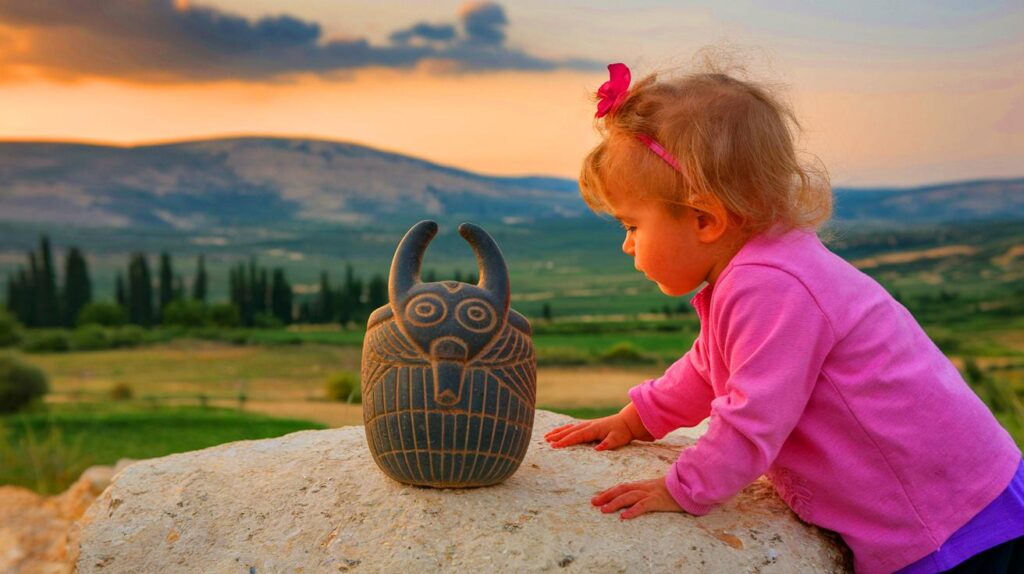| In Brief |
|
During an ordinary walk, a three-year-old girl stumbled upon an object that was anything but ordinary. What was initially thought to be a simple stone turned out to be an ancient Egyptian amulet, thousands of years old. This coincidental discovery, made on a trail in southern Israel, has captivated archaeologists and shed light on the hidden treasures beneath our feet. This fascinating story reminds us that history can emerge at any moment, even through the innocent curiosity of a child.
An Unexpected and Precious Discovery
On February 8, 2025, Ziv Nitsan, a three-year-old girl, made a discovery that astonished her parents and experts alike. While walking on a path in Israel, she picked up what appeared to be a mere stone. However, after a little dusting off, her parents realized they had stumbled upon an ancient artifact. The object, approximately the size of a child’s palm, turned out to be an Egyptian amulet. According to the Israel Antiquities Authority, this amulet dates back to the Middle Bronze Age, a period ranging from 2,100 to 1,600 BCE. This discovery underscores the significance of attentiveness and interest in history, which is sometimes just beneath the surface.
The amulet, designed in the shape of a scarab, holds particular significance in ancient Egyptian culture. Scarabs symbolized the renewal of life and were often used as seals or amulets. Daphna Ben-Tor, a curator at the Israel Museum, confirmed the authenticity of the object, emphasizing that such artifacts were often found in tombs or significant buildings. Ziv’s discovery not only highlights the importance of archaeology in Israel but also the richness of its historical heritage.
Tel Azekah: A Premier Historical Site
The discovery was made at Tel Azekah, a hill located about 64 kilometers south of Tel Aviv. This archaeological site is famous for its historical wealth. Tel Azekah is recognized as a fortified Judean city that has withstood several eras. Excavations conducted by Tel Aviv University have revealed that this region thrived during the Middle and Late Bronze Ages, attesting to its strategic and cultural significance.
The excavation director, Oded Lipschits, points out that the scarab found by Ziv adds to an impressive list of Egyptian and Canaanite discoveries. These artifacts illustrate the close ties between Canaan and Egypt, demonstrating mutual cultural influences. The biblical legend of David and Goliath also originates from Tel Azekah, adding an additional layer of intrigue to this historic site. Through the continuous efforts of archaeologists, Tel Azekah continues to unveil its secrets, enriching our understanding of this complex region.
The Importance of Accidental Discoveries
Ziv Nitsan is not the first child to make an archaeological discovery in Israel. According to Yoli Schwartz, spokesperson for the Antiquities Authority, such finds occur several times a year, often after rains expose hidden artifacts. This phenomenon illustrates that chance finds play a crucial role in archaeology.
These occasional discoveries remind us that everyone, even a child, can contribute to uncovering the past. They highlight the importance of curiosity and a keen eye for our surroundings. Ziv Nitsan’s discovery of the amulet is a perfect example of how invaluable objects can be revealed by the serendipities of daily life. It encourages everyone to explore and appreciate the history around us, often lying just beneath the surface.
Egyptian Artifacts: Symbols of Life and Power
Scarabs, like the one discovered by Ziv, held a central place in Egyptian culture. These objects were more than mere ornaments; they were imbued with deep symbolic meanings. The scarab, in particular, was associated with the god Khepri, symbolizing rebirth and the cycle of life.
These amulets were often meticulously crafted, bearing inscriptions and designs that reflected their owner’s social or religious status. In ancient Egypt, possessing a scarab was a sign of divine protection and prosperity. Archaeologists have found numerous scarabs in royal tombs, temples, and homes, underscoring their significance in daily life and the afterlife. Ziv Nitsan’s discovery not only highlights Egyptian craftsmanship but also the cultural and religious significance of these fascinating objects.
The finding of the Egyptian amulet by a three-year-old prompts reflection on the unexplored riches of our global heritage. As archaeologists continue to excavate sites like Tel Azekah, what other historical secrets may still be buried, just waiting to be uncovered by a curious eye?








